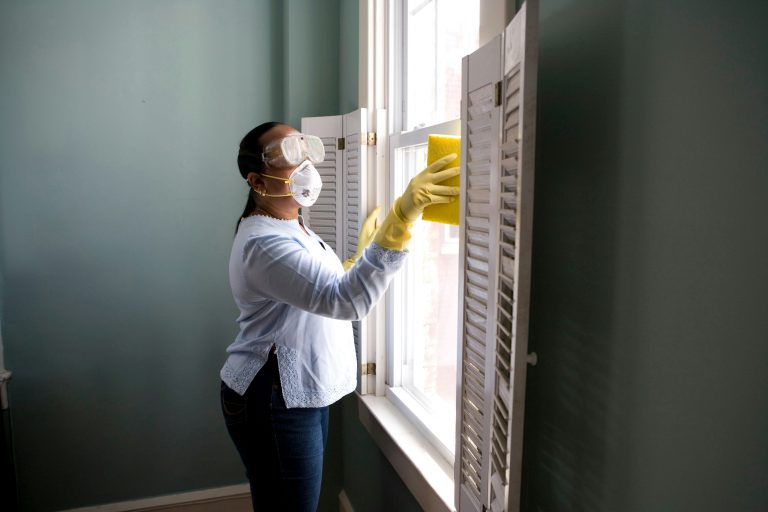Ultimate Guide to Cleaning Mould:
Tips and Tricks for a Healthier Home

Mould is more than just an unsightly nuisance; it can pose serious health risks and cause long-term damage to your home. Whether it’s in the bathroom, basement, or on walls and ceilings, mould thrives in damp, humid environments. The good news is that with the right tools and techniques, you can get rid of mould effectively and prevent it from returning.
Why Mould Is a Problem
Mould grows in moist conditions and can spread quickly if not dealt with. Some common health effects of mould exposure include:
- Respiratory issues: Mold spores can irritate the respiratory system, leading to coughing, sneezing, and wheezing.
- Allergic reactions: Mould can trigger allergies in sensitive individuals, causing skin rashes, eye irritation, or nasal congestion.
- Damage to property: Mould can weaken building materials and cause stains that are difficult to remove.
Cleaning mould promptly and properly is essential not just for health reasons but to maintain your home’s structural integrity.
Step-by-Step Guide to Cleaning Mould
1. Gather Your Cleaning Supplies
Before you start cleaning, make sure you have the following supplies:
- Protective gear: Wear gloves and a mask to avoid inhaling spores or coming into contact with the mould.
- Cleaning solutions:
- White vinegar
- Baking soda
- Hydrogen peroxide
- Commercial mould cleaner (optional)
- Scrub brush (non-abrasive)
- Sponge or cloth
- Bucket
- Water for rinsing
2. Identify the Source of Moisture
Before cleaning the mould, it’s crucial to address the root cause of the problem. Mould thrives where there’s moisture, so check for:
- Leaky pipes or roofs
- Poor ventilation (especially in bathrooms or kitchens)
- Condensation issues on windows or walls
Fixing the moisture issue will prevent mould from returning.
3. Prepare the Area
- Ventilate the Space: Open windows or use a fan to ensure proper airflow during the cleaning process. If the room is very damp, try using a dehumidifier.
- Seal Off the Area: If possible, close off the affected room to prevent spores from spreading to other parts of your home.
- Remove Items: Clear the area of furniture or other items that could get in the way.
4. Cleaning Methods for Different Surfaces
Walls and Ceilings:
- Spray vinegar directly on the mouldy spots and let it sit for at least 60 minutes. Vinegar kills most types of mould and is safe to use on most surfaces.
- Use a scrub brush or sponge to scrub the mouldy area.
- Rinse the area with clean water and dry it thoroughly to prevent future growth.
- For stubborn mould, mix baking soda with water to create a paste and apply it to the affected area. Let it sit for 10–15 minutes before scrubbing.
Tiles and Grout:
- Mix hydrogen peroxide (3%) and water in equal parts in a spray bottle.
- Spray the solution onto the tiles and grout, allowing it to sit for 10–15 minutes.
- Use a brush to scrub away the mould, paying extra attention to grout lines.
- Rinse with clean water.
Wood:
- Wood can be more delicate, so avoid using harsh chemicals that could damage the surface.
- Instead, mix equal parts of water and vinegar in a spray bottle and apply it to the affected area.
- Wipe the surface with a clean cloth and repeat if necessary.
- Dry thoroughly, as moisture can cause wood to warp.
Fabric and Upholstery:
- Wash fabric items in hot water, if possible, to kill the mould spores.
- For upholstery, mix vinegar and water and blot the mouldy areas. You can also use hydrogen peroxide for tougher stains.
- After treatment, leave the fabric to dry completely in a well-ventilated area.
5. Dispose of Contaminated Materials
If mould has spread to porous materials like carpets, insulation, or drywall, it may be difficult or impossible to remove completely. In these cases, it’s best to discard the affected material to prevent the mould from spreading further.
6. Prevent Future Mould Growth
Once you’ve cleaned the mould, take steps to prevent it from coming back:
- Increase ventilation: Use exhaust fans in bathrooms and kitchens, and open windows when possible to promote airflow.
- Fix leaks: Repair any leaks in pipes, walls, or roofs immediately.
- Control humidity: Use a dehumidifier in damp areas like basements and laundry rooms to reduce moisture levels.
- Regular cleaning: Check areas prone to mould, like showers, window sills, and basements, regularly and clean them if you notice moisture buildup.
When to Call a Professional
In some cases, mould removal may require professional help. If the mould infestation covers a large area (greater than 10 square feet), or if you have health concerns, it’s best to call a cleaning service that specializes in mould removal. Professionals have the equipment and expertise to ensure the problem is thoroughly addressed and that your home is safe.
Conclusion
Mould is a common but serious issue that requires immediate attention. By following these cleaning tips, you can effectively remove mould from your home and create a healthier living environment. Remember, the key to long-term mould prevention is controlling moisture levels and maintaining good ventilation throughout your home.
For those tough-to-reach or large-scale mould problems, don’t hesitate to reach out to a professional cleaning service. We at SM Cleaning Service specialize in safe and effective mould removal, so you can rest easy knowing your home is in good hands.
Need help with mould removal? Contact us today for expert cleaning services that will keep your home fresh and safe!

